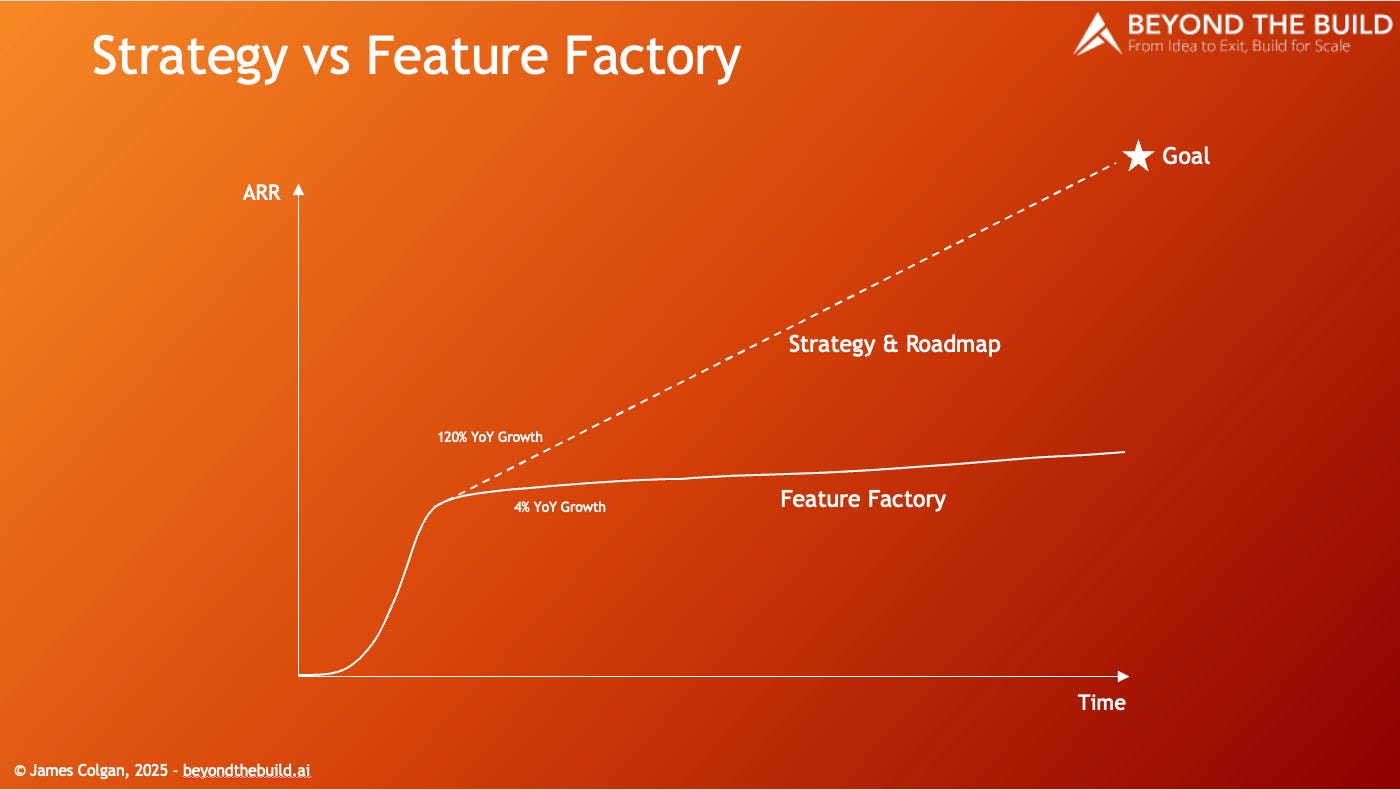From Feature Factory Chaos to Roadmap Clarity
How We Built High-Impact Roadmaps at Slack
Every growing product company eventually hits the same wall. Customers, prospects, and sales reps generate an endless stream of feature requests. Engineering capacity feels stretched. Marketing wants fresh stories to tell. Leadership is pushing for revenue growth, shorter sales cycles, and clear differentiation to drive up average contract value or sales prices.
The result, too often, is a roadmap that feels more like a reaction log than a strategy. The result is product teams are driven to implement features from the the customer or account executive who pushes most persistently (Squeaky Wheel); the person in the room with the biggest paycheck (HiPPO); or the last customer someone spoke to (recency bias).
If this is you, you’re in a feature factory. It is not sustainable, and the opportunity costs are enormous.
A roadmap should be a strategic asset. It should capture where the company is focusing, what customer problems are worth solving, and how product investment will drive business outcomes. The challenge is to take the long flat list of features the company could build and turn it into a thought-through roadmap of what they should build to meet the company’s goals.
Using examples from my experience at Slack and elsewhere, we’ll walk through a detailed process to turn chaos into clarity. A long list of seemingly disconnected features into a coherent roadmap.
Here are the steps I’ll detail. (🔒 for our paying community subscribers.)
Market segmentation: deciding who you’re building for and get alignment across the product and go-to-market organizations
🔒 Product Domain Mapping: how to get out of the weeds of features and focus on what matters
🔒 Jobs-to-be-Done: how to become customer-centric and business value-oriented
🔒 Kano value stack classification: how to make tradeoffs explicit and intentional
🔒 Goals, OKRs, and KPIs: how to align customer needs and business goals
🔒 Bring it all together: decide how to allocate investments across the value stack
🔒 Build the roadmap: where prioritization becomes real by balancing engineering capacity
By the end, you’ll see how to move from a messy list of asks to a structured system for prioritization that is repeatable, transparent, and strategic.
Why Every Product Company Needs a Prioritization Framework
Ideas are cheap and easy to come by. The difference between company success and failure is the speed of execution. And the greatest drag on execution is the speed and clarity of decision-making.
Without a clear decision-making framework, roadmaps become dominated by short-term pressure. This may feel like a successful approach as code is shipped and some sales are made. But it’s not sustainable as over time growth slows and frustration builds across the organization:
Sales feels blocked in deals.
Customer success struggles to manage churn.
Engineering suffers from whiplash as priorities shift.
Leadership sees a limited connection between roadmap items and financial outcomes.
In short, you’re living inside a Feature Factory at 4% annual revenue growth. And from the investors’ perspective, you’re building a lifestyle business and not a “rocket ship” that will deliver outsized returns on their investment.
A prioritization framework doesn’t eliminate tradeoffs, it makes them transparent. Instead of fighting over features, the team debates segment focus, value creation, and alignment with company goals. More than anything, it’s these debates and the decisions made where the value lives. These tough conversations are what build a healthier organization delivering better outcomes.
So, how do we do this? Read on!
Step 1: Define Market Segments
The first step is to get clarity about who you are serving now. Different customer segments have different requirements, costs to serve, and revenue potential.
For example:
An enterprise company with complex infrastructure may care deeply about integrations, compliance, and security.
A mid-market business using modern SaaS stacks may prioritize speed of setup and in-product dashboards.
In the early days of a company, when founder-led sales dominate and you’re in search of Product-Market Fit (PMF), you’ll take any customer meeting, close any deal, and build any feature just to show traction and validate hypotheses.
That’s great, to a point. Once you’ve gathered all of this data, you need to take a step back and ask yourself, “Who do we serve now?”. Even if you’re product is horizontal, you need focus to direct your finite resources. Product teams need to focus on a coherent set of capabilities to build, and your go-to-market (GTM) team needs to focus on a coherent set of prospects to increase sales predictability and velocity.
Treating every prospect as “the customer” does not help prioritization and focus.
How to define segments:
Vertical: industry, e.g., consumer packaged goods (CPG) , fintech, healthcare
Opportunity sizing: Total Addressable Market, number of prospects, growth profile
Size: SMB, mid-market, enterprise
Tech stack: Salesforce vs HubSpot, Slack vs Teams
Geography: US, EU, global
Regulatory profile: strict vs light
Buyer and user mix: marketers, IT, agencies, operations
Anchor each segment with real customer examples. Instead of abstract labels like “tech-forward enterprise,” use “Nike”. It makes planning and conversations more tangible. These are customers you’ve engaged with and understand their needs. Customer names connect the product and GTM teams and facilitate alignment.
The output of this exercise is a one-slide grid showing the different market segments and the key attributes of each. These can be stack-ranked by factoring in opportunity sizing, current product fit, and current GTM fit. Then choose one market segment to focus on for the next twelve months.
Keep reading with a 7-day free trial
Subscribe to Beyond the Build to keep reading this post and get 7 days of free access to the full post archives.



